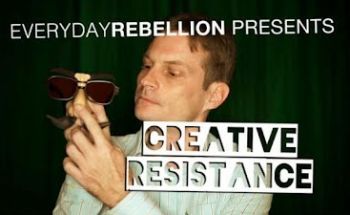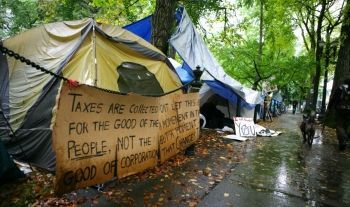
Publisher:
Bonnie King
CONTACT:
Newsroom@Salem-news.com
Advertising:
Adsales@Salem-news.com

~Truth~
~Justice~
~Peace~
TJP
May-22-2013 19:40

 TweetFollow @OregonNews
TweetFollow @OregonNews
Analyzing Strategies in Nonviolent Protest
Theresa Griffin-Kennedy Salem-News.comAn article on Organizing strategy by Theresa Griffin-Kennedy.
 The "unofficial" leader of Serbia's Otpor movement, Srdja Popovic... |
(PORTLAND, OR) - In nonviolent protest, success or failure can depend on a variety of strategies that can determine the final outcome: whether or not the protesters are able to declare victory at the end of the day. One way that “victory” can be determined, is by planning when participant departures take place and how long a protest will last. This strategic planning can allow protesters to claim the demonstration or protest as having achieved its positive end. The questions of departure timing and duration of a protest are narrow and infrequently examined dynamics of nonviolent protest that deserve further attention and study. How does this timing enhance or prevent successful nonviolent protest? Why does it matter? Lets take a look at the Occupy protests in Portland Oregon.
A large number of people support the ideas behind the Occupy movement. They understand that the current economic system is not sustainable for this country. When 2% of the population enjoys 90% of the wealth, the system is not workable or fair: poverty and despair are the natural result of social and economic disparity. This is a system out of balance and sinking under the weight of its foundational roots: it is mired in patriarchy and economic infelicity.
"Hierarchical systems exist in part because the subordinates submit as a result of seeing themselves as inferiors. Therefore, two steps to challenge and end the hierarchical system are first, to get the members of the subordinate group to see themselves as full human beings who are not inferior to anyone; and, second, to get them to behave in ways consistent with that enhanced view of themselves.” (Sharp, pg 425).
The protests and creation of the Occupy movement seemed inevitable, given global overpopulation and an unfair distribution of wealth across countries and nations. Taxation and inequity are at the root of the problem. In the USA, unfair tax practices are enforced and promoted for the wealthy to enjoy.
Wealthy corporate America protects and insulates its members by encouraging politicians to institutionalize unfair taxes on lower income groups. Many people, often struggling to survive by working 2 and 3 jobs, must shoulder a disproportionate burden of the costs for our nation. This contributes to a growing sense of frustration and anger at the way things are.
And so the Occupy movement came about. Part of the organizational structure of the Occupy protests are being conducted by young, idealistic students who want to make a difference and draw attention to the reality of poverty and despair in America. Using the power of social media and the blessing and assistance of professional organizers, this movement (with roots in Europe) attracted thousands of people to the riverfront in the fall of 2011. After an energetic rally, huge crowds of people with disparate concerns and agendas, marched through the city. Then, in celebration and with determined purpose, they occupied Lawnsdale and Chapman Squares in downtown Portland.
People of all ages, cultures, and communities wanted to bring home the point that everyone has a right to life, liberty, and the pursuit of happiness. To realize these rights, food, shelter, and security are paramount.
What began as a political movement and celebration sprouted numerous multi-faceted wings. Soon, the homeless were gravitating to the camp sites, as well as multiple local progressive groups and organizations. A community kitchen was organized, doctors and nurses volunteered to run a community health center at the heart of the occupation and dozens of journalists and writers created a library and communicated with local media and media organizations. The occupation became a city in itself, with all of the ramifications of this reality, including a few overly zealous rabble rousers. As the smell of marijuana burning and accumulating litter became onerous, the city and various organizers were faced with a moral dilemma.
Members of the city council of Portland and those who organized and sustained the protest wondered, Do we take care of and support this seemingly helpless, under-represented, and too-often ignored population or should be focus on larger goals of the city or political movements? As it turned out, the organizers decided that the needs of the homeless, the mentally ill, and myriad dispossessed populations were critical.
The medical tent and communications teams at the occupation continued their efforts to care for everyone participating. More campsites were added, the daily food kitchen was expanded, and meals were planned and prepared to sustain the movement. This attracted more homeless, more organizers, and police. Eventually crime became a problem. Sometimes the crimes were committed by participants and other times crimes were perpetrated by the homeless, who were coming to the site daily. The corporate press in Oregon, with encouragement by the city administrators, claimed that the damages to trees and shrubs in the part were a “disaster” and that assaults and problems with underage, runaway teens were increasing.
Student activists were sometimes distracted by these complex issues and some minor exhaustion set in, but social activists rallied and brought in their own media and researchers from local colleges, libraries, and social movements. It was determined that the occupy area actually had some of the lowest crimes relative to many areas of the city and that much of the remonstrations from city hall were political in nature. But the damage to the lawns and parks was very real. However, it did become abundantly clear that the occupation could not continue forever.
The movement and its goals were portrayed in the local media as having “become convoluted and lost focus” and became the source for community criticism.“One's energy may be deflected to minor issues and applied ineffectively.” (Sharp, pg 442). Issues related to the homeless, minors, and pollution, were becoming serous social problems.
 Occupy Portland - Salem-News.com photo by Dexter Phoenix |
Sometimes a serious social or political movement can be compromised because outside forces undermine it. When this occurs, a restatement and reassessment of the goals of the group are needed. This conversation occurred in the Occupy movement, with regular rallies and General meetings where these problems were discussed at length.
These collective meetings determined that other demonstrations were needed. When there were planned demonstrations in other sections of Portland, these sit-in's and marches were often very successful in calling attention to needed bridge repairs, inefficient public services, and an inequitable distribution of economic resources. Many of these protests targeted local banks. Sometimes a variety of distractions occurred, but organizers all over the city and the nation were energized by this very public drama. An overly aggressive response by the Portland Police Bureau, instigated by city hall, led to some unfortunate confrontations and avoidable arrests. Inevitably, tensions developed between the movement, city hall, and local law enforcement.
Some of the most disturbing elements in this public political drama were orchestrated by the local corporate press, with the encouragement of agents in city hall, who had become impatient with the ongoing protest at their front door. Attention was called to some factions among the protesters who referred to themselves as anarchists. This corporate verbiage was intended to inflame public passions against the movement and often, at the smaller protest sites at local banks, both protesters and battalions of police stayed active, after other Occupy protesters had Left.
What were being hailed as victorious demonstrations by Occupy organizers were being called a series of crimes in progress by law enforcement. The corporate press continued to emphasize what city hall perceived as crime while local progressive organizations and the movement itself understood that the stories of “undesirables” causing strife and conflict for law enforcement were overblown and belied the facts on the ground.
During the Occupy movement and occupation of the two squares, calls to Portland law enforcement peace officers rose 91% in the central downtown Portland area. Some of the 'trouble makers' were the mentally ill homeless population acting out at the campsites, begging, drinking and using drugs.These troubled and stressful events became lingering problems for the movement, creating strain between organizers, law enforcement, city hall, and everyday people. This drama often diluted the ambitions, goals, and perceived success of the movement.
Probably the most damage these machinations did to the movement was to give the corporate press fuel to create the false illusion that the movement and the engaged and politically- committed students were misguided and essentially troublesome in their efforts to create more economic fairness for our country as a whole. In fact, the 99% of struggling, working, low-income Americans represented by this movement and these demonstrations were well-served by the focus on these events. Conversations began which had not yet been considered previously. For some this seemed like a new dawn.
Gene Sharp, in his book on methods of nonviolent strategies, Waging Nonviolent Struggle, explains the importance of understanding at what point protesters leave a demonstration, sit-in or march, and declare the event a success for their movement, having increased “cause consciousness” for their movement. This is an extremely important aspect of social protest, because the nature of perceptions of the protest can be so potentially precarious, given the presence of law enforcement officers and the risk of violent physical conflict.
When stragglers or hangers-on stay long after the event is 'over' they run the risk of coming to blows with law enforcement officers, and ultimately tarnishing the over-reaching image of the movement and its participants. But with an ongoing public protest such as Occupy, there is no clearly-drawn line in the sand or ending point. Clearly, there should be, as demonstrated in Sharp's serious, well researched and classic text on nonviolent strategies.
When the integrity, reputation and image of the organizers is the most important element to protect, the importance of all protesters understanding the dynamics of a scene cannot be undervalued or ignored. The media organizers and professional groups supporting the Occupy movement (churches, radio stations, Jobs with Justice, unions, local colleges, etc.) understood the importance of creating and maintaining the public image of the integrity of the protesters and organizers through clear, open, stated goals, presented to opponents in an atmosphere of mutual respect. “Openness will facilitate (but not ensure) the opponents understanding of the nonviolent struggle groups motives, aims, intentions and plans.” (Sharp, pg 370). Too often, with over-sized battalions of police called out in response to ingenuous remonstrations in the corporate press by city hall, the goals and aspirations of the protesters were lost in the shuffle and avoidable violence ensued.
There are many diverse elements to a successful protest, but probably the most strategic and important is knowing when to end the protest. When two sides want vastly divergent things, there are often attempts to smear the opposing group. To maintain an image of moral impeccability, the nonviolent protesters must create and sustain an image of moral awareness and conviction that cannot be easily demolished. And police officials, as representatives of city hall, must be equally meticulous in preserving the peace instead of provoking violence. This creates a delicate balance, but a necessary balance that must be nurtured and sustained.
When protesters know when they must leave and do so as a group, much like the young protesters in Serbia during the 2000 overthrow of Slobodan Milosevic, they can leave a solid image of victory. And media outlets can eagerly and happily disseminate the idea that their protest, sit-in, or march was indeed successful. But when protesters stay long after the goal of the protest or march has been achieved, they run the risk of undermining the entire campaign.
More real conversations can continue when both sides learn more about the power of nonviolent group dynamics. It is hopeful that Gene Sharp's insightful and time-proven methods for enduring nonviolence are shared with more people. A more public understanding of his methods and these insights might help create significant social change.
As we struggle for justice, critical voices in the cutting edge: creative arts, literature, poetry and other forms of media, can help us protect and embellish clear messages about achieving these goals. The timing and duration of protests must be critical factors in planning and supporting organized political statements. The collective cultural heritage and political harmony of countless nations across the globe may hang in the balance. We must remain vigilant as we move forward, working for social change and peace.
* For more information on utilizing nonviolent strategies, read Gene Sharp's definitive book, Waging Nonviolent Struggle or contact Professor Tom Hastings, at Portland State University, (for volunteer or internship opportunities) in the Graduate department of Conflict Resolution. Dr. Hastings can be reached through email and by phone...hastings@pdx.edu, 503-725-9173, NH 221. Office Hours: Tuesday: 2:00 PM - 4:00 PM or by Appointment.
(No portion of this essay may be reproduced without express permission from the author, Theresa Griffin Kennedy)
Theresa Griffin-Kennedy~

Theresa Griffin Kennedy is a writer and social activist, completing a masters degree at Portland State University in Adult Education. Her goal upon completing the degree will be to teach incarcerated offenders creative writing.
With a focus on the middle east and human rights, Ms Kennedy has written articles on the human rights of women in the middle east, the homeless and the mentally ill.
Poetry and the art of the personal essay are also strong focal points and continue to be explored in her writing. Ms Kennedy continues to write, submit her writing and be published.
Any comments, questions or remarks, regarding this work of creative non-fiction can be emailed to kennedyt@pdx.edu
Ms. Theresa Kennedy-DuPay~ - Feel free to peruse my personal website, click the active link down below and enjoy. https://sites.google.com/a/
 |
 |
 |
Articles for May 21, 2013 | Articles for May 22, 2013 | Articles for May 23, 2013


Salem-News.com:
googlec507860f6901db00.html


Terms of Service | Privacy Policy
All comments and messages are approved by people and self promotional links or unacceptable comments are denied.
Anonymous May 23, 2013 1:32 pm (Pacific time)
Rage in London after 'Unforgivable' Beheading//There is shock and fury in Britain following the gruesome murder of a soldier by Muslims in Woolwich,... “London is having a hard time dealing with this kind of cruel terror. Muslims beheading a soldier – that is an unforgivable deed.” There were riots and confrontations in different parts of London Thursday, and two mosques were reportedly attacked. In recent years, Muslims have become dominant in several neighborhoods in London, to the chagrin of the native locals, and there have been reports that fundamentalists have been trying to enforce Sharia law in the neighborhoods. EDL leader Tommy Robinson was among the crowd and explained: "They're chopping our soldiers' heads off. This is Islam. Our next generation are being taught through schools that Islam is a religion of peace. It's not. It never has been. What you saw today is Islam," he added. "Everyone's had enough." I OVERHEARD SOMEONE SAY THIS IN BIBLE STUDY THIS AM: Where they exist any where on the planet: WIPE THEM OUT IN THE MOST PAINFUL OF WAYS, LET NONE EXIST, NONE!
That's funny, because wankers from GB have been chopping heads and souls for hundreds of years as a pack of self-righteous colonizing bigots with your noses in the air and the dark skinned people at your feet.. Your indignant tone will only cause disgust. I don't even think your kind of vitriol causes people to hate, anyone except you that is. I try not to respond in these terms but geez louise, the only thing that needs to be "wiped out" on this planet is you and your ilk. I'll get out the toilet paper and start straight away.. For the record, we don't respond well to comments from low IQ bigots, just be warned.
[Return to Top]©2025 Salem-News.com. All opinions expressed in this article are those of the author and do not necessarily reflect those of Salem-News.com.